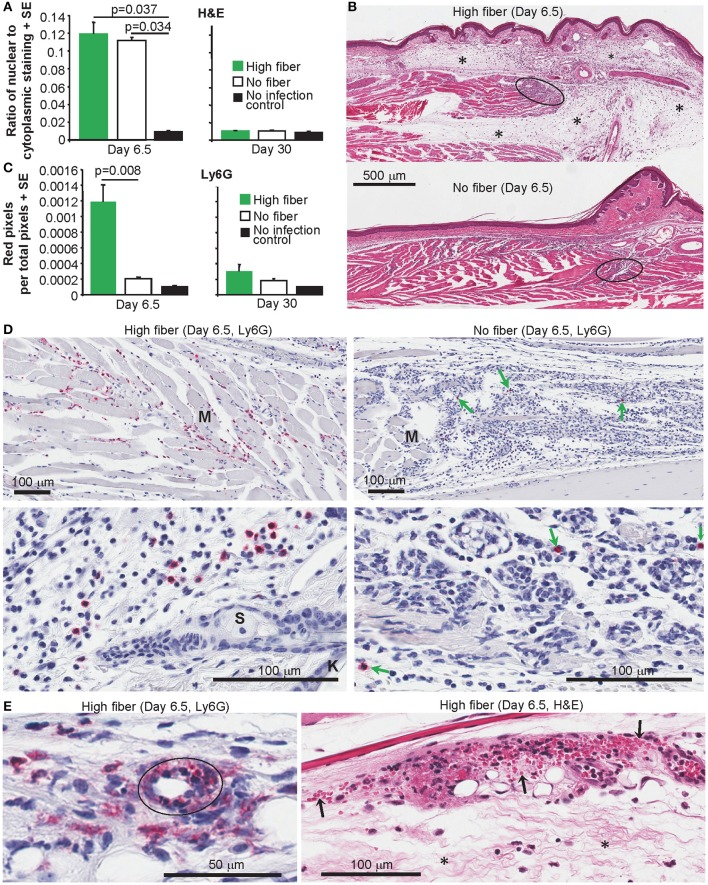Exacerbation of Chikungunya Virus Rheumatic Immunopathology by a High Fiber Diet and Butyrate.
Chikungunya virus (CHIKV) is a mosquito transmitted alphavirus associated with a robust systemic infection and an acute inflammatory rheumatic disease. A high fiber diet has been widely promoted for its ability to ameliorate inflammatory diseases. Fiber is fermented in the gut into short chain fatty acids such as acetate, propionate, and butyrate, which enter the circulation providing systemic anti-inflammatory activities. Herein we show that mice fed a high fiber diet show a clear exacerbation of CHIKV arthropathy, with increased edema and neutrophil infiltrates. RNA-Seq analyses illustrated that a high fiber diet, in this setting, promoted a range of pro-neutrophil responses including Th17/IL-17. Gene Set Enrichment Analyses demonstrated significant similarities with mouse models of inflammatory psoriasis and significant depression of macrophage resolution phase signatures in the CHIKV arthritic lesions from mice fed a high fiber diet. Supplementation of the drinking water with butyrate also increased edema after CHIKV infection. However, the mechanisms involved were different, with modulation of AP-1 and NF-κB responses identified, potentially implicating deoptimization of endothelial barrier repair. Thus, neither fiber nor short chain fatty acids provided benefits in this acute infectious disease setting, which is characterized by widespread viral cytopathic effects and a need for tissue repair.
Authors
Natalie A Prow; Thiago D C Hirata; Bing Tang; Thibaut Larcher; Pamela Mukhopadhyay; Tiago Lubiana Alves; Thuy T Le; Joy Gardner; Yee Suan Poo; Eri Nakayama; Viviana P Lutzky; Helder I Nakaya; Andreas Suhrbier
External link
Publication Year
Publication Journal
Associeted Project
Systems Immunology of Human Diseases
Lista de serviços
-
As antisense RNA gets intronic.As antisense RNA gets intronic.
-
Androgen responsive intronic non-coding RNAs.Androgen responsive intronic non-coding RNAs.
-
Conserved tissue expression signatures of intronic noncoding RNAs transcribed from human and mouse loci.Conserved tissue expression signatures of intronic noncoding RNAs transcribed from human and mouse loci.
-
The intronic long noncoding RNA ANRASSF1 recruits PRC2 to the RASSF1A promoter, reducing the expression of RASSF1A and increasing cell proliferation.The intronic long noncoding RNA ANRASSF1 recruits PRC2 to the RASSF1A promoter, reducing the expression of RASSF1A and increasing cell proliferation.
-
Antisense intronic non-coding RNA levels correlate to the degree of tumor differentiation in prostate cancer.Antisense intronic non-coding RNA levels correlate to the degree of tumor differentiation in prostate cancer.
-
Insight Into the Long Noncoding RNA and mRNA Coexpression Profile in the Human Blood Transcriptome Upon Leishmania infantum Infection.Insight Into the Long Noncoding RNA and mRNA Coexpression Profile in the Human Blood Transcriptome Upon Leishmania infantum Infection.
-
Long non-coding RNAs associated with infection and vaccine-induced immunityLong non-coding RNAs associated with infection and vaccine-induced immunity
-
Comparative transcriptomic analysis of long noncoding RNAs in Leishmania-infected human macrophagesComparative transcriptomic analysis of long noncoding RNAs in Leishmania-infected human macrophages
-
SARS-CoV-2 Selectively Induces the Expression of Unproductive Splicing Isoforms of Interferon, Class I MHC, and Splicing Machinery Genes.SARS-CoV-2 Selectively Induces the Expression of Unproductive Splicing Isoforms of Interferon, Class I MHC, and Splicing Machinery Genes.

